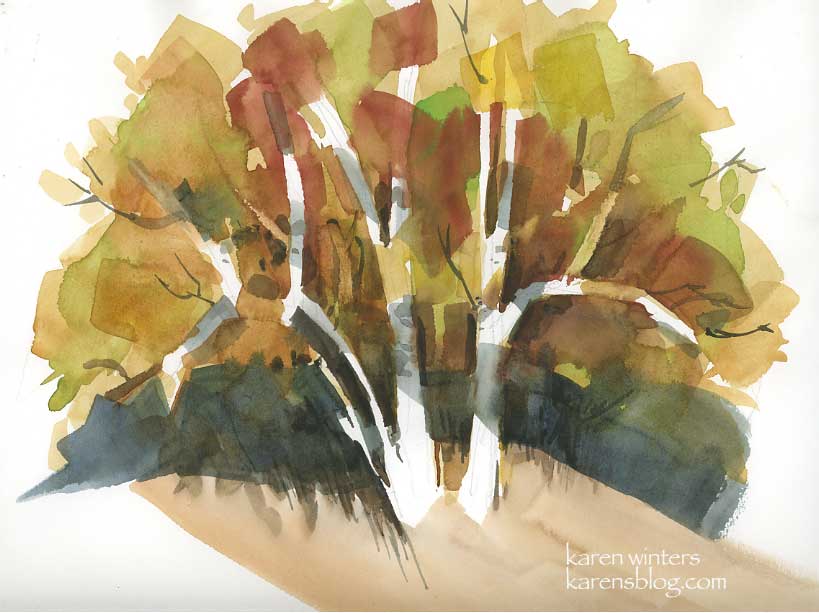Abstract sycamore
This was an exercise in abstracting natural forms in my watercolor class. Our teacher, who paints marvelously, is encouraging us to think more in terms of abstraction and symbol rather than literally painting what we see in front of us. I ‘get it’ and am doing the exercises and such, but there’s still a part of me that wants a tree to look like a tree with all the leafy bits (although not TOO fussy.) I’m guessing that my style will even out somewhere between the two, under the influence of my own predilections, likes and dislikes and gentle influence of other teachers yet to come. I love the California school painters with their abstraction and wild colors, but I also love Sargent and his beautiful loose renderings that simultaneously reveal and suggest. And I adore the crisp geometric patterns of Dong Kingman and the sweeping emotional scenes of Emil Kosa and the controlled wildness of Charles Reid. All of them – they all touch my heart, much as I like early music like that of Talis as well as jazz (but only if it swings.) Must we fit in only one mold?
Synchronistically, I opened a random art magazine to a random page and came up with an interview with Tony Pro an oil painter. Pro relates how he had the opportunity to meet Richard Schmid (author of Alla Prima and many other outstanding books.) Pro says that Schmid was kind but honest in reviewing his work, and advised him to be true to himself and not to copy others. Pro concluded with what what is today’s art advice: “Don’t paint like someone else to impress someone – work only to impress yourself.”
Geometric trees may be sophisticated, but for now they just don’t swing. Maybe they will some day – I’ll have to wait and see.





Don West
April 11, 2007
I like this. I think there is a lot more beauty and message in the non-rendered painting or drawing anyway. It seems to me the idea of faultlessly and accurately rendering an object or scene is nothing more than an exercise in copying.
Certainly it takes a great level of skill, patience, and craftsmanship to do that…and not that many people possess those faculties. But it seems more a demonstration of skill than art to me. It doesn’t seem to evoke the thoughts and feelings of the artist.
At the same time, too loose seems to be more like play with no interpretable thought or feeling. As though there were no objective in placing the paint on the paper. So, there is a place where skill, thought and looseness collide to create interpretable art which has meaning.
Sargent was able to evoke the meaning of a scene, person, or object with just large brush strokes (or lack of them). His paintings are much more enjoyable (at least to me) than “accurate” paintings and drawings.
But hey, there is something to be admired in all works of art. Even those of a child or a complete beginner.
Casey
April 12, 2007
This is an interesting discussion, Karen. I agree that you have to be true to yourself, and to be honest, I would recognize this painting as one of yours without hesitation. But I think that forcing ourselves to try something new can subtly change the way we work, and push the boundaries a little. I say this as someone who also resists abstraction. If nothing else, it’s interesting to feel strong resistance to something, just to be clear about what it is we do like.
Shirley
April 12, 2007
Absolutely beautiful Karen! I tried to figure out what made me like it so much – and I think I really love the colors. But I also am drawn to the abstract qualities – and I know I could NEVER do it! Maybe I need some of your lessons!
ella
April 12, 2007
hi, karen. i love your watercolor works and i want to learn watercolor too. can i link to your blog? thanks..
my best regards.
Roberto Bobrow
April 12, 2007
Hi, Karen. Your teacher’s proposal brings me memories of my sculpture teacher wen I was young. He (who’s still working at 92) was a disciple of Zadkine, disciple of Bourdelle, who departed from Rodin’s sensuallity to found modern sculpture with his constructivist approach. These exercises where tough to me as well; I used to feel that the output was not MY ouvre but HE’s.
The true is that this approach gives you a more tight aprehension of the subject’s escence. Paradoxically in a line close to that of Oriental Art as in your “whistaria branch” painting. “Less is more” as they say; some touches of details over an almost abstract basis could be more expresive and “realistic” than an overwhelmed accumulation of details, because the true is that the human eye can’t see many details at a sight.
I’m sort of an organic testing instrument of this, because I have hereditary color deficient perception (it seems my retine lacks some cone cells). As such, I can see a lot of features in these kind of pictures but, in contrast, I get lost in others, like the “cactus cottage”.
I know my own work is far from being good example of the master’s lesson; I aquired many vices to suit the demandings of mediocre commanders in the newspapers enviroment. But I can still recognize the true and the beauty of their teachings. And, be sure, it shows more and more in your work. My best.
Ronell
April 12, 2007
I couldn’t agree more with everything you’ve said here, Karen…there is so much wonderful beauty and knowledge on completely different roads and if you take a stroll down them, they unconsciuosly enrich you and lead you to discover who you are and that, I think is “your own style”. I like this abstract for its color and shapes.
Ronell
wendy
April 12, 2007
I look at the painting and see it in different ways – great shapes and colours, and then okay, it’s a tree. I think the artist has to have fun with the paints, enjoy ‘playing’ with the possibilities of the medium and certainly not trying to get a literal perfect representation of a landscape/scene/subject. Of course I fail, time after time, and get fussy and too detailed, or else heavy-handed and sloppy. Just…sometimes, it works.
w.
Fawzan Barrage
April 12, 2007
I really enjoyed your blog very much. I love your latest painting of the tree. The colours work very well and the flat strokes don’t look stiff at all to me. Speaking of Jazz, even flat notes can be jazzy! And so your work is. Jazzy in every way. I like it!
Wendee
April 12, 2007
I have been away for a few days and have missed so much. These are so wonderful. You may not think they swing, but they sure do sing to me!
Felicity
April 14, 2007
I think it’s a lovely painting and I love the colours! But as for abstraction, it has to be an authentic response by the artist to what they are seeing. So I disagree with Donn, that is shows skill because if you do it to impress and not because it’s your true vision, that is not art. Personally I find the reality of things I see as too beautiful to change. A leaf’s shape and the subleties of tone and colour are lost by abstraction but another emotion might be substituted by the artist. Both are valid as long as they are authentic responses.
Felicity
April 14, 2007
Sorry, I meant ‘ it is art’ not ‘ shows skill’.